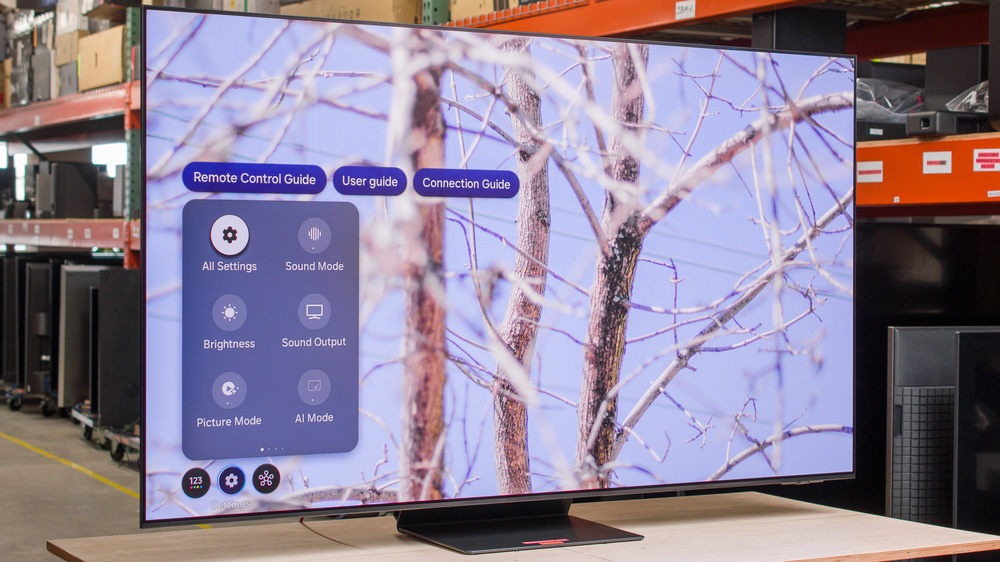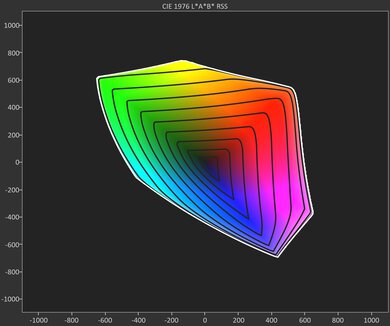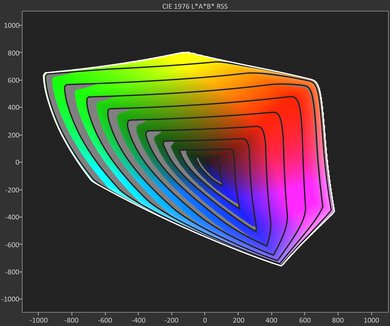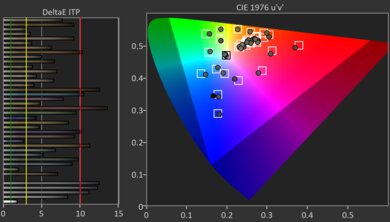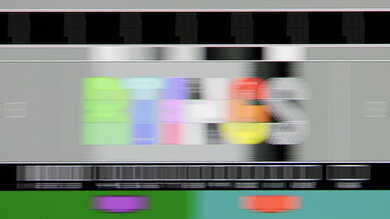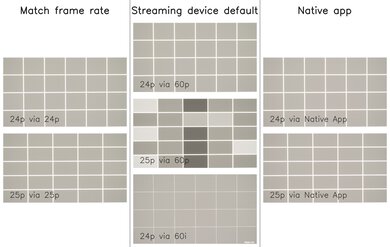The Samsung S95F OLED is Samsung's flagship 4k TV for 2025. It replaces the Samsung S95D OLED and sits above the Samsung S90F OLED. It features an improved QD-OLED panel that Samsung claims is up to 30% more efficient, delivering higher peak brightness, and like the S95D, the screen is treated with a matte anti-glare coating. It's powered by Samsung's custom NQ4 AI Gen3 Processor and runs the 2025 version of Samsung's proprietary Tizen OS. The TV has 70W 4.2.2 channel speakers built-in and supports HDR10+ and Dolby Atmos, but as usual for Samsung, there's no support for Dolby Vision HDR or DTS audio formats. We bought and tested the 65-inch model, but it's also available in 55, 77, and 83-inch sizes.
Our Verdict
The Samsung S95F is an amazing TV for any usage. It's a fantastic choice for a bright room thanks to its high peak brightness, and distracting glare from lights or windows is a thing of the past thanks to its matte anti-reflective coating. HDR content looks better than ever thanks to its incredibly colorful screen and perfect contrast. It's also a dream machine for gaming, with a nearly instantaneous response time, low input lag, support for VRR, and for PC gamers, a 165Hz refresh rate. It also has an incredibly wide selection of smart features, so you spend less time navigating through menus and more time watching your favorite content.
Near-infinite contrast ratio for perfect blacks with no blooming around bright highlights.
Nearly perfect viewing angle for a consistent image from any spot in the room.
Incredibly bright.
Wide color gamut for an incredibly lifelike experience.
Anti-glare coating eliminates distracting glare from bright lights.
Black levels are significantly raised in a bright room.
The Samsung S95F is an amazing TV for home theater use. It looks incredibly good in a dark room thanks to its nearly infinite contrast ratio and perfect uniformity. Colors are vivid and lifelike without being overblown, and it tracks the content creator's intent well. It also gets extremely bright, so highlights in HDR stand out well. Unfortunately, there's some unwanted edge sharpening that can't be disabled, and it doesn't support Dolby Vision HDR or DTS audio formats. Like all OLEDs, there's some response time stutter present, so slow camera movements aren't as smooth as they're intended to be.
Near-infinite contrast ratio for perfect blacks with no blooming around bright highlights.
Incredibly bright.
Wide color gamut for an incredibly lifelike experience.
Does an outstanding job displaying HDR content at the intended level or brightness.
Noticeable stutter due to the TV's fast response time.
Doesn't support Dolby Vision HDR or DTS audio formats.
Undefeatable edge enhancement in all picture modes.
The Samsung S95F looks excellent in a bright room. The matte anti-reflective coating does an incredible job reducing the glare from windows or lights to the point that they're barely even visible. Colors remain bright and vibrant even in a very bright room, so the image doesn't look washed out. On the other hand, blacks raise considerably in a bright room, so it loses the deep inky blacks that OLEDs are known for.
Incredibly bright.
Wide color gamut for an incredibly lifelike experience.
Anti-glare coating eliminates distracting glare from bright lights.
Black levels are significantly raised in a bright room.
The Samsung S95F is excellent for watching sports. It looks great in a bright room and has a superb viewing angle, making it a great choice for watching the big game during the day with a large group of friends. It does a great job upscaling low-resolution feeds, but it doesn't do much to remove artifacts from low-quality sources like most streaming sports channels or even older cable boxes. On the other hand, motion is crisp and smooth thanks to its incredibly fast response time.
Nearly perfect viewing angle for a consistent image from any spot in the room.
Incredibly bright.
Wide color gamut for an incredibly lifelike experience.
Anti-glare coating eliminates distracting glare from bright lights.
Does a great job upscaling low-resolution content like DVDs or cable TV channels.
The Samsung S95F is an incredible TV for gaming. It delivers an extremely responsive gaming experience thanks to its nearly instantaneous response time and low input lag. It supports a wide range of gaming features, including VRR, and it has a fast 165Hz refresh rate for PC gamers. You can also stream your favorite games from streaming services like Xbox or NVIDIA GeForce NOW, and you can pair your favorite controller directly to the TV for a console-free gaming experience. It delivers fantastic picture quality when gaming, and games mastered in HDR look fantastic thanks to its high peak brightness and wide color gamut.
Low input lag for a responsive gaming experience.
Incredibly bright.
Nearly instantaneous response time for no noticeable blur behind fast motion.
Wide color gamut for an incredibly lifelike experience.
The Samsung S95F has excellent peak brightness. It's bright enough in HDR that small specular highlights stand out from the darker background really well, and bright scenes are stunning. In SDR, the peak brightness is high enough that you can easily overcome glare.
Incredibly bright.
Since the Samsung S95F is an OLED, it displays remarkably deep and inky blacks with no blooming around highlights when viewed in a dark room.
Near-infinite contrast ratio for perfect blacks with no blooming around bright highlights.
The Samsung S95F has fantastic colors. Colors in both HDR and SDR are bright and vibrant. It's also a very accurate TV out of the box, especially in SDR. There are a few noticeable hue errors in HDR, but it's still great, and everyone but the strictest color enthusiasts will be pleased.
Wide color gamut for an incredibly lifelike experience.
Note: We're in the process of improving our tests related to image processing, but this score should give you a general idea of how a TV performs overall with its image processing capabilities.
The Samsung S95F has great processing overall. It has very good upscaling capabilities, but there's some noticeable forced edge enhancement that can't be disabled. It handles low-bitrate content well, preserving fine details properly, but it doesn't do much to smooth out macroblocking in dark scenes. It has outstanding gradient handling, with no visible banding in most content. Finally, the TV has outstanding PQ EOTF tracking overall, so most content is displayed the way the content creator intended, but some shadow details are a bit raised.
Does a great job upscaling low-resolution content like DVDs or cable TV channels.
Fantastic gradient handling.
Does an outstanding job displaying HDR content at the intended level or brightness.
Undefeatable edge enhancement in all picture modes.
The Samsung S95F is an incredibly responsive gaming TV. It has a nearly instantaneous response time, delivering crystal clear motion at any refresh rate. It has incredibly low input lag up to its maximum refresh rate of 165Hz, and it supports all three types of VRR, ensuring a nearly tear-free experience from any source.
Low input lag for a responsive gaming experience.
Nearly instantaneous response time for no noticeable blur behind fast motion.
We're in the process of fixing the way we evaluate a TV's overall motion handling. This section is currently broken, and the score isn't indicative of how well a TV handles motion overall.
Performance Usages
Changelog
-
Updated Oct 22, 2025:
We retested the TV with Firmware 1125 and saw an increase in overall brightness, especially with sustained 25% windows. We've updated the HDR Brightness, HDR Brightness in Game Mode, and SDR Brightness sections with the new results. Furthermore, we updated the results in the SDR Color Volume section, since there's also a solid uptick in SDR BT.2020 coverage with the new firmware.
-
Updated Oct 21, 2025:
This review has been updated to Test Bench 2.1. We wrote text for the newly added Micro-Judder test, refreshed the text in the updated Judder section, and tweaked the text in the renamed Response Time Stutter section.
- Updated Oct 21, 2025: We added text to the new Micro-Judder section and refreshed the text in the updated Judder and Response Time Stutter sections after converting the review to TV 2.1.
-
Updated Jul 30, 2025:
Added a note to the PQ EOTF Tracking section about Samsung's removal of HGIG.
Check Price
Differences Between Sizes And Variants
We bought and tested the 65-inch Samsung S95F, and these results are also valid for the 55 and 77-inch models. The 83-inch model uses a WOLED panel, with similar peak brightness overall but worse color luminance. Note that the last five letters in the model number (AFXZA in this case) vary between retailers and individual regions, but there's no difference in performance. Unlike the Samsung S90F and the Samsung S85F, there doesn't appear to be any panel lottery for this model. Except for the 83-inch model, all sizes use QD-OLED panels in all regions.
| Size | US Model | Short Model Code | Panel Type |
|---|---|---|---|
| 55" | QN55S95FAFXZA | QN55S95F | QD-OLED |
| 65" | QN65S95FAFXZA | QN65S95F | QD-OLED |
| 77" | QN77S95FAFXZA | QN77S95F | QD-OLED |
| 83" | QN83S95FAEXZA | QN83S95F | WOLED |
Our unit was manufactured in March 2025, as seen on the label.
Popular TV Comparisons
The Samsung S95F is an incredible TV. It pushes OLED technology to new heights, significantly increasing the peak brightness over 2024 models while still maintaining the impressive colors QD-OLED panels are known for. It's also a gaming powerhouse, making it an easy choice for PC or console gamers alike. It uses the same panel as the Sony BRAVIA 8 II OLED, and both of these compete directly with the LG G5 OLED, with each of the three models trading blows on brightness, color volume, and processing. It's not perfect, though, and a few of Samsung's design decisions, like the Slim One Connect box and the matte anti-glare screen finish, are just as controversial in 2025 as they were when they were first introduced.
For more options, check out our recommendations for the best OLED TVs, the best gaming TVs, and the best TVs for watching movies.
The Samsung S95F and the LG G5 are both fantastic OLED TVs that deliver exceptional picture quality. The LG is slightly more enticing for use in a dark home theater, since it gets a bit brighter in HDR, has better processing, and supports Dolby Vision. However, the Samsung still looks incredible in dark rooms. In bright rooms, blacks are raised on the Samsung, but its anti-reflective coating is so effective that it essentially eliminates glare, making it the better choice for very bright environments. As good as the LG is, it has diagonal lines in darker scenes that are noticeable when sitting up close. It also exhibits snow-like noise in certain dark scenes that’s noticeable from a normal viewing distance, along with a few other issues that may bother some people, making it hard to recommend over the Samsung.
The Samsung S95F OLED is better than the Samsung S90F OLED. The S95F is brighter in HDR, especially in SDR; it really excels in standard dynamic range. The S95F is more accurate in HDR out of the box, supports 4k @ 165Hz for PC gamers, and comes with the versatile One Connect box. Finally, its matte coating handles direct reflections far better than the S90F.
The Samsung S95F OLED is a noticeable improvement over its predecessor, the Samsung S95D OLED. The new model gets significantly brighter, allowing it to better overcome glare in a bright room and to deliver a more impactful HDR experience. Samsung has also improved the matte anti-glare coating, resulting in one of the best TVs ever made in terms of glare reduction.
The Samsung S95F OLED is better than the Sony BRAVIA 8 II OLED in most ways. The Samsung is significantly brighter in SDR, has a matte coating that essentially eliminates reflections, and does a better job retaining its color vibrancy in a well-lit room, all of which makes it the superior bright-room OLED. The Samsung also displays brighter highlights in HDR and has less banding in color gradients. For gamers, the Samsung is a bit better thanks to its lower input lag and support for up to 4k @ 165Hz.
On the other hand, the Sony cleans up more artifacts in low-bitrate content and does a better job of upscaling. The Sony also supports the popular Dolby Vision HDR format and passes through DTS audio formats.

We buy and test dozens of TVs yearly, taking an objective, data-driven approach to deliver results you can trust. Our testing process is complex, with hundreds of individual tests that take over a week to complete. Most of our tests are done with specially designed test patterns that mimic real content, but we also use the same sources you have at home to ensure our results match the real-world experience. We use two main tools for our testing: a Colorimetry Research CR-100 colorimeter and a CR-250 spectroradiometer.
Test Results
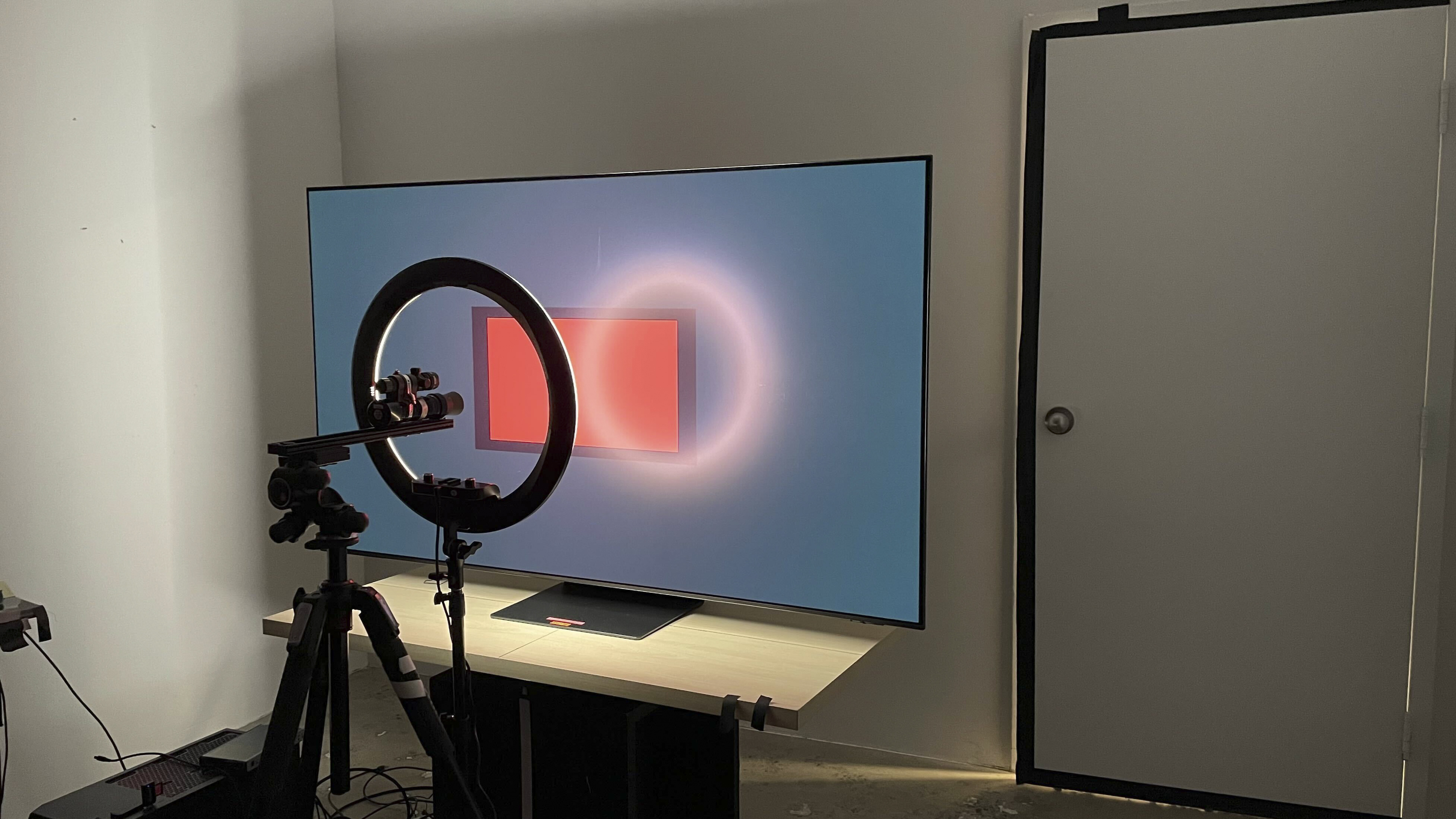
The Samsung S95F OLED has amazing peak brightness when watching HDR content. Small and medium-sized specular highlights stand out incredibly well, even giving many Mini LED models a run for their money. The improved OLED stack delivers much brighter full-screen performance as well, so bright daylight shots are far more impactful than previous generations of OLED.
Like all OLED TVs, the S95F has a feature called ASBL designed to protect the panel from extended exposure to high peak brightness. This feature is a bit more aggressive than usual on this TV, resulting in a lower 10% sustained window. This is simply a protection feature of the TV, and it's not at all noticeable with regular content.
These results are in the most accurate, calibrated settings mode, with HDR Tone Mapping set to 'Static' and the Color Space set to 'Auto'. If you want to get the most brightness out of this TV and don't care as much about accuracy, adjusting these two settings has a significant impact on peak brightness, as shown with the following real scene brightness measurements:
| HDR Tone Mapping Setting | Color Space Setting | Cityscape (cd/m2) | Landscape (cd/m2) | Hallway (cd/m2) |
|---|---|---|---|---|
| Static | Normal | 545 | 214 | 632 |
| Native | 541 | 215 | 616 | |
| Active | Auto | 833 | 634 | 1136 |
| Normal | 875 | 621 | 1197 | |
| Native | 863 | 514 | 1177 |
The Samsung S95F is slightly brighter when using Game Mode, but it's not a significant difference. The above results are with Game HDR set to 'Basic' and HDR Tone Mapping set to 'Static.'
Unfortunately, Samsung removed HGIG with firmware update 1125.9. Their intention was to move it to the "Original" Game Genre setting, but it's still not working properly as of firmware 1125.
Results with 'HDR Tone Mapping' set to 'Active':
- Hallway Lights: 1114 cd/m²
- Cityscape: 677 cd/m²
- Landscape Pool: 293 cd/m²
The peak brightness in SDR is amazing. It's bright enough to easily overcome glare in a bright room, even when watching very bright content like sports.
The Samsung S95F is an OLED and doesn't have a backlight, so its self-lit pixels give it the same performance as a TV with perfect local dimming and no zone transitions. We still film the zone transition video on the TV so you can see how it compares to an option with local dimming.
The Samsung S95F has superb color volume in SDR. Like almost any TV, it has full coverage of the most commonly used Rec. 709 color space, but it also has nearly perfect coverage of the wider DCI-P3 color space. Its coverage of the widest BT.2020 color space is excellent, and unlike the LG G5 OLED, it doesn't struggle with lighter shades. Overall, it's a fantastic TV to watch the odd SDR content that's mastered in these wider color spaces, or if you like punchier colors by forcing Rec. 709/sRGB content into a wider color space.
| Volume ΔE³ | DCI-P3 Coverage |
BT.2020 Coverage |
|---|---|---|
| L10 | 99.98% | 83.18% |
| L20 | 99.96% | 84.12% |
| L30 | 99.94% | 84.38% |
| L40 | 99.92% | 86.34% |
| L50 | 99.91% | 87.34% |
| L60 | 99.90% | 87.60% |
| L70 | 100.00% | 85.52% |
| L80 | 100.00% | 83.50% |
| L90 | 100.00% | 84.01% |
| L100 | 100.00% | 96.62% |
| Total | 99.95% | 85.92% |
This TV has fantastic color volume in HDR. It displays dark, saturated colors perfectly thanks to its nearly infinite contrast ratio. It has better color luminance than the LG G5 OLED, meaning colors are just as bright as pure white since it doesn't rely on a white subpixel to boost the overall luminance in bright scenes.
There's currently a bug with the 'Auto' Color Space setting, and it's not working properly. These results are with it set to 'Auto', but due to the bug, the measured yellow luminance is too low. While it's possible to compensate for this bug, doing so reduces the color space considerably, so we left it alone.
The Samsung S95F is incredibly accurate even without a full calibration. Gamma is extremely close to the 2.2 target, and only dark scenes appear slightly brighter than they should. The white balance and color temperature are fantastic, and there are no noticeable color errors.
The calibration process is quick and easy on this TV, even if it's not really needed since it's already so accurate out of the box. After calibration, it's nearly perfect in SDR, with no noticeable issues.
See our full calibration settings.
The Samsung S95F OLED has great HDR accuracy before calibration. The biggest issue is its white balance, with significant errors in grayscale throughout. The color temperature is nearly perfect. Colors are great overall, but there are noticeable hue errors throughout, especially in more saturated colors.
The HDR calibration process isn't very effective on this TV. Although the white balance improved a bit, both bright and dark shades are still noticeably off, but everything in-between is good. Color accuracy improved a bit, but there are still noticeable hue errors.
Samsung removed HGIG with firmware update 1125.9. Their intention was to move it to the "Original" Game Genre setting, but it's still not working properly as of firmware 1125. This means that most games won't be displayed at the correct brightness level, and it's especially problematic for Switch 2 players, as HGIG is needed to properly calibrate that console's HDR output.
The Samsung S95F's EOTF tracking is outstanding overall, but it's not perfect. Blacks and near-blacks are displayed perfectly, but shadow details are a bit raised. Mid-tones and bright highlights fare better with no significant issues. There's a sharp roll-off near the TV's peak brightness, which means the TV prefers hitting the highest peak brightness possible over preserving gradation in bright areas.
This TV does a great job preserving fine details when streaming content from low-bandwidth sources, but there's still noticeable macro blocking in dark scenes, so you don't get as clean an image when watching low-bitrate content as you do on a TV like the Sony BRAVIA 8 II OLED.
This TV does a great job upscaling low-resolution content like DVDs or cable TV channels. Fine details and hard-coded text are hard to make out, but most content looks great overall. Unfortunately, it applies edge enhancement to all content, even with the Sharpness slider set to '0'. This is present in all picture modes, but it's slightly better in Filmmaker Mode.
Gradients look fantastic on this TV, with just a bit of banding in some darker shades. It's really not noticeable in real content unless you're looking for it from close up.
This TV has very low input lag when set into Game Mode, which ensures a responsive gaming experience. It's a bit higher outside of Game Mode, so navigating menus on external devices feels a bit sluggish. It supports a maximum refresh rate of 165Hz at both 1080p and 4k resolutions.
The TV supports all common resolutions up to 4k @ 165Hz. It doesn't support 144Hz, but since most PC gamers are best off outputting a 165Hz refresh rate, this isn't a big deal most of the time. Chroma 4:4:4 signals are displayed properly with all supported resolutions when the TV's input label is set to 'PC' with Input Signal Plus enabled, which is important for text clarity.
Since the HDMI ports on the TV's Slim One Connect box are limited to 40Gbps, the full 165Hz refresh rate only works with sources that support Display Stream Compression, or DSC. Most recent graphics cards support this, but if you have an older HDMI 2.1 graphics card, you'll be limited to 4k @ 120Hz.
The Samsung S95F supports all three types of variable refresh rate (VRR) technology to reduce screen tearing. It works well across a very wide refresh rate range and supports sources with Low-Frame-Compensation (LFC). This ensures you get a more consistently tear-free gaming experience, even when your games can't keep up and the frame rate drops down very low.
Like all OLEDs, the TV's CAD at its maximum refresh rate of 165Hz is fantastic. Pixels transition to their target RGB level almost instantly with no noticeable overshoot, so fast motion is very sharp. The slight dip in the CAD charts is caused by the TV's refresh cycle and isn't noticeable.
Dropping down to sources with a maximum refresh rate of 120Hz, like a console, has no noticeable impact on the TV's motion handling. Fast motion is clear, with no noticeable overshoot or motion artifacts. The slight dip in the CAD charts is caused by the TV's refresh cycle and isn't noticeable.
Due to the sample-and-hold nature of OLED TVs, there's noticeable persistence blur when gaming at 60Hz, but the CAD is still extremely good. Pixels transition very quickly, with no noticeable motion artifacts. The slight dip in the CAD charts is caused by the TV's refresh cycle and isn't noticeable.
The Samsung S95F is fully compatible with everything the base PS5 offers, like 1440p @ 120Hz and 4k @ 120Hz, as well as HDMI Forum VRR. It doesn't support 8k signals from the PS5 Pro, though. It also supports Auto Low Latency Mode, so you don't have to worry about switching to Game Mode to get the lowest input lag.
The Samsung S95F is fully compatible with almost everything the Xbox Series X|S offers, including 1440p @ 120Hz, 4k @ 120Hz, HDMI Forum VRR, and FreeSync Premium Pro. It also supports Auto Low Latency Mode, so you don't have to worry about switching to Game Mode to get the lowest input lag. Unfortunately, Dolby Vision isn't supported on the TV, so gaming in Dolby Vision isn't possible.
Unfortunately, due to the nearly instantaneous pixel response time of the TV, there's noticeable response time stutter in all content, especially in shots with slow camera movement.
The Samsung S95F OLED TV is free from 24p micro-judder regardless of the source. There's also no micro-judder when watching 25p content from the TV's native apps or from external devices sending a 25Hz signal. However, there's some noticeable micro-judder when watching 25p content via a 60p signal, like when using older streaming devices.
As initially reported by HDTVTest, the TV has a very minor instance of micro-judder right after starting a video or when exiting a full screen of black, but this lasts less than a second and goes away completely after that, so it's not a big deal at all.
The TV automatically removes judder from all sources when watching movies or shows that are in 24p, even if they're in a 60Hz signal, like from a cable box or an older streaming device. It also removes judder from 25p sources if you're using the TV's native apps or an external device that sends a 25Hz signal. However, it doesn't remove judder from 25p sources that are being sent via a 60p signal. Furthermore, the duration of frames is incredibly inconsistent, which makes motion look jerky and distracting when watching 25p content via 60p.
The TV has a nearly instantaneous response time, resulting in incredibly clear motion with almost no blur behind fast-moving objects when watching content. There's no noticeable overshoot or other artifacts. The slight dip in the response time charts is caused by the TV's refresh cycle, but it's not noticeable.
This TV doesn't have a traditional backlight and doesn't use pulse-width modulation (PWM) to dim each pixel, but it's not completely flicker-free. There's a slight dip in brightness that corresponds to the TV's refresh rate. This differs from the PWM flicker on TVs with LED backlights and occurs on every OLED we've tested. It's not noticeable, and most people won't be bothered by this, but it can still bother people who are extra sensitive to flicker.
The TV has an optional black frame insertion (BFI) feature that reduces the appearance of persistence blur caused by the TV's nearly instantaneous response time. It can only insert black frames at a 60Hz refresh rate, this feature is not available at 120 or 165Hz.
This TV has an optional motion interpolation feature. It's effective at improving the overall appearance of motion, but there are noticeable artifacts in just about any content, including slower scenes that most TVs have no issue with.
The matte anti-reflective coating on the Samsung S95F OLED does a superb job at reducing the intensity of direct reflections, so you barely see any reflections on this TV. It's even better than the Samsung S95D OLED that this TV replaces.
Unfortunately, the matte screen coating comes with some significant downsides, as this TV does a poor job of displaying deep blacks in a bright room. Since it reduces reflections by scattering light across the screen, blacks look increasingly gray as your room becomes brighter.
The Samsung S95F displays excellently saturated colors in a bright room. The TV's perceived color volume does decrease noticeably in a bright room, especially with low-luminance colors, but you still get incredibly saturated colors since its color volume is so impressive to begin with.
The Samsung S95F OLED TV uses a unique subpixel structure. Instead of having all three subpixels in a row, each pixel forms a triangle, with the larger green subpixel at the top. This leads to color fringing; on a bright window on a Windows PC, you might notice a green fringe at the top since that's where the green subpixel is. Similarly, there's a purple fringe at the bottom of bright windows, as that's where the red and blue subpixels are. Furthermore, with this subpixel arrangement, text has just okay clarity on a PC, as Windows ClearType settings aren't designed for this subpixel structure and can't correct for it.
The TV uses quantum dots to achieve high color peaks with excellent separation between blues, greens, and reds. This gives the TV great color purity and allows it to display an incredibly wide range of colors. The S95F uses a third-generation electroluminescent layer, which Samsung Display advertises as up to 30% more efficient.
The TV's matte coating causes the hazy pixels you see in the photo, but the haziness isn't noticeable when using the TV.
The TV itself only has two inputs: a USB-C service port and an input for the One Connect cable. All the audio/video and USB connections are housed on the external Slim One Connect Box instead.
Although the TV supports HDMI 2.1 bandwidth on all four HDMI ports, all four ports are limited to 40Gbps. The built-in tuner is limited to ATSC 1.0, as Samsung has dropped support for ATSC 3.0 from their U.S. TV Lineup since 2024.
The Samsung S95F supports many audio formats, including all Dolby Digital options. Unfortunately, it doesn't support DTS formats, which is disappointing, as many Blu-rays use DTS for their lossless audio tracks. Dolby Digital+ passthrough is also limited to 5.1 channels instead of the full 7.1 support. It's unclear if this is a bug or an intentional decision by Samsung to limit support, but the other Samsung TVs we've tested in 2025, like the Samsung S85F OLED and the Samsung QN90F, have the same limitation.
7.1 channel LPCM only works with sources that allow you to manually override the EDID, like a PC. If you can't override the EDID, it's limited to 5.1.
Like all Samsung TVs, the Samsung S95F doesn't support Dolby Vision, but it does support the similar HDR10+.
The Samsung S95F has a very premium design and looks incredible, but it's nearly identical to the Samsung S95D it replaces. It's extremely thin, with a slim, uniform profile that looks great in any room. The external Slim One Connect box gives you great flexibility when it comes to cable management, as you can either mount it to the back of the TV, the back of the stand, or place it away from the TV.
The back of the TV is very plain, and since it uses the Slim One Connect box to house all of the inputs, there's only a small cutout that houses the OCB connection and a USB-C service port. Since the cables all go to the OCB, there's no cable management on the TV itself.
Given how small the speakers are with this TV's extremely thin profile, it sounds surprisingly decent. It doesn't get very loud, and it lacks deep bass, but the sound profile is fairly well balanced, aside from a slight dip in the mids that makes some dialogue sound a bit muted.
